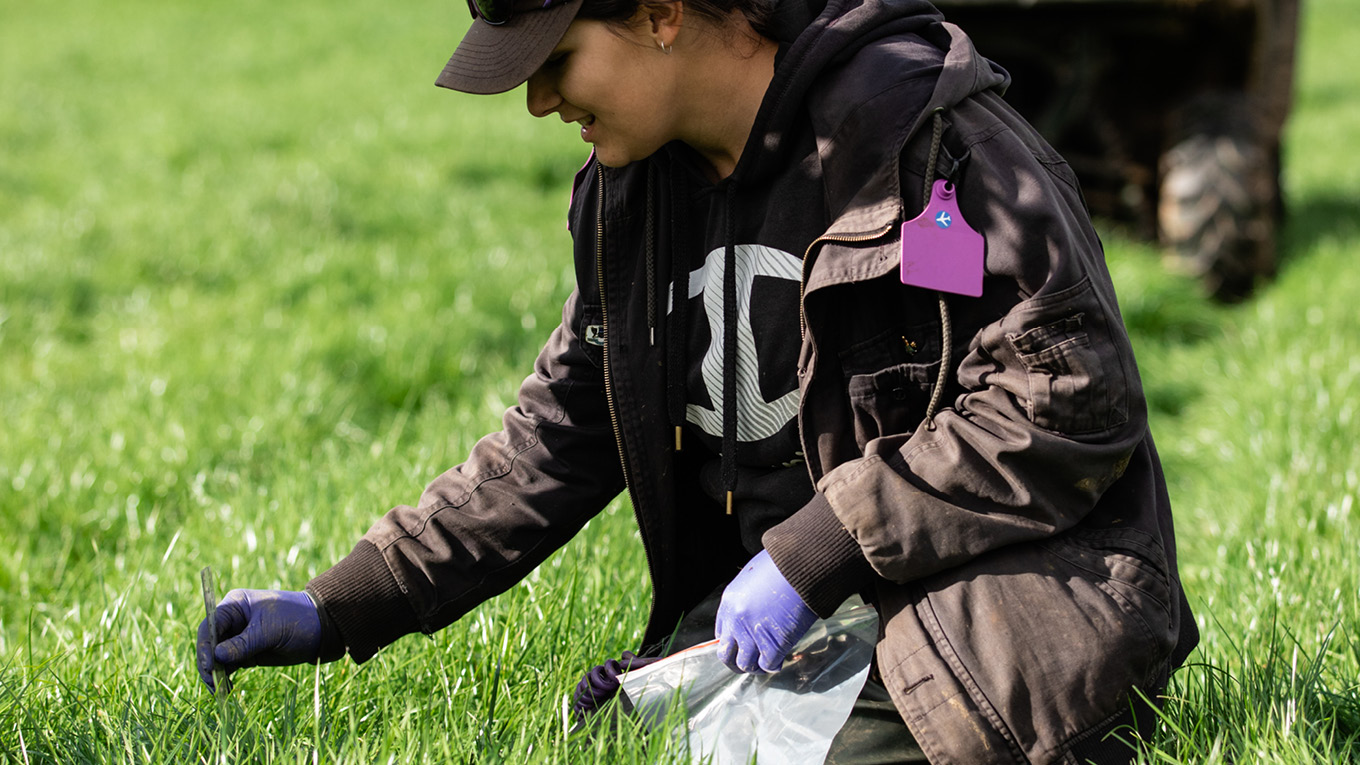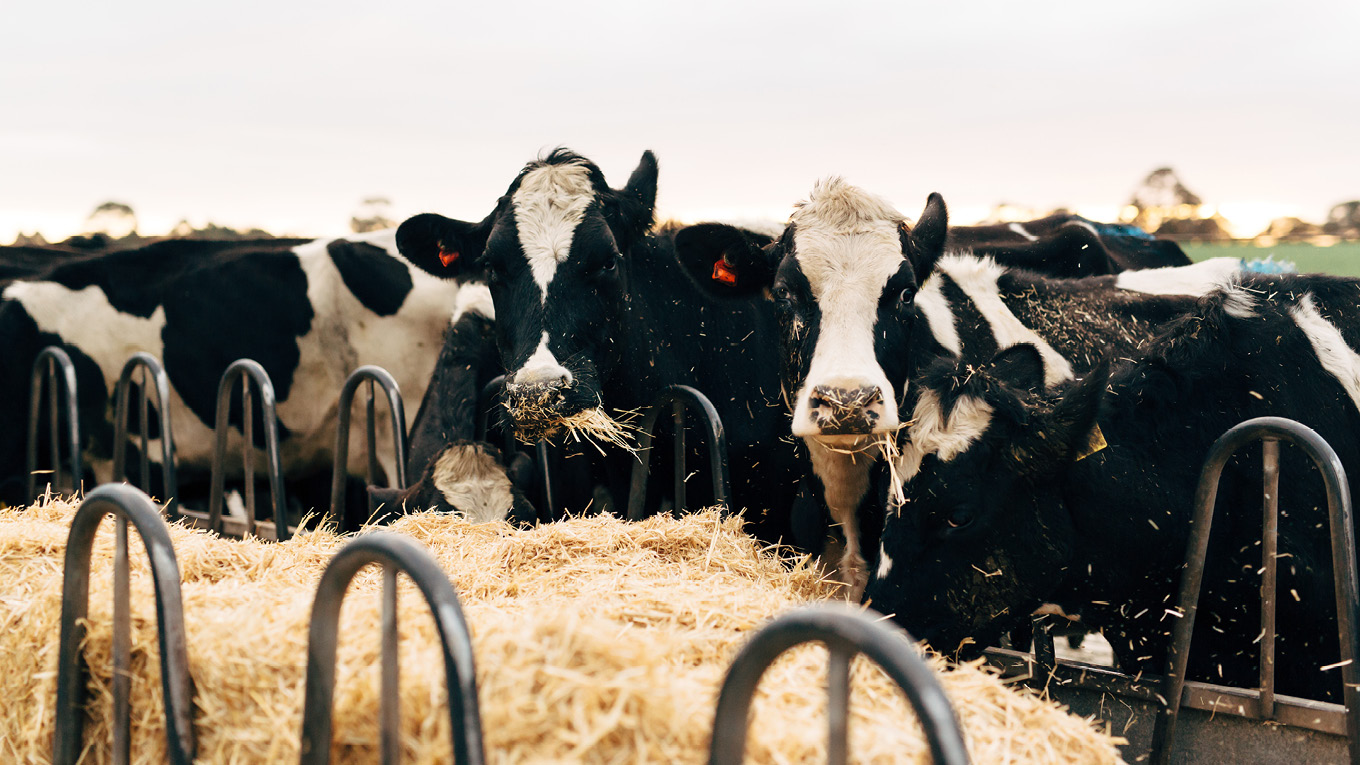Feed Minerals
Feed minerals for Australian dairy cattle
A balanced supply of minerals in feed is essential for animal health and production in all classes of dairy cattle. The three main minerals to consider when formulating diets for dairy cows are calcium (Ca), phosphorus (P) and magnesium (Mg).
Calcium during lactation
Calcium is generally the main mineral which needs to be added to the diet of lactating dairy cows in Australia. This is because milk is rich in Ca (typically 1.2–1.3 grams per litre) and most dairy cow diets are relatively low in Ca.
A cow at 100 days in milk producing 30 litres per day typically excretes about 38 grams of Ca in milk and also needs to absorb about 19 grams of Ca for essential bodily maintenance functions, bringing the total daily Ca requirement to 56 grams.
Dietary Ca from plant sources tends to be absorbed inefficiently, varying from 30 to 60% depending on feed type, so the total dietary Ca supply in the above example needs to be in the order of 150 grams per day. This equates to approximately 0.8% in feed dry matter (DM), which is within the recommended Ca level (0.8 to 1.0%) in the diet for lactating dairy cows.
Pasture typically contains 0.5 % Ca in DM (range 0.3% to 0.9%). Therefore, pasture alone does not meet Ca requirements of lactating dairy cows. Further, this Ca deficit becomes much greater as soon as cereal grains are added to the diet, as these are very low in Ca (typically less than 0.1% in DM).
Supplementation of the diet with Ca is therefore critical to maintain animal health and production. Ground limestone is normally the most cost effective source of Ca. In the above example, supplementation with 140 grams of limestone will ensure Ca requirements are fully met at a cost of 1–2 cents per cow per day.
Phosphorus and magnesium during lactation
Phosphorus and magnesium requirements of lactating dairy cows in Australia are often met by a diet of pasture and concentrates. In the example above, cow requirements for P and Mg are 75 and 40 g/day, respectively. This equates to 0.4% of DM intake for P and 0.25 to 0.3% of DM intake for Mg. These requirements are met by a diet of ryegrass (15 kg DM) and barley (5 kg) and further supplementation with these minerals will not be required.
Rumen8
Individual circumstances can vary dramatically and need to be checked regularly to ensure that mineral requirements are met at all times. This is where the computer program Rumen8 can help.
Rumen8 is a free user-friendly tool to help farmers formulate dairy cow diets which have the correct balance of energy, protein, fibre and other nutritional components for Australian dairy cows at different stages of production. Rumen8 also calculates demand and supply for Ca, P and Mg.
Rumen8 can be used by dairy farmers to regularly adjust dairy cow diets with periodic help from a nutritionist. Rumen8 can be downloaded for free.
Dry cows and transition cows
The Rumen8 program can also be used to check Ca, P and Mg requirements for dry cows (from dry‑off to four weeks before calving) and for transition cows. It is very important to get the balance of Ca, P and Mg correct for cows during these periods to minimise health problems after calving.
Ca demand is greatly reduced during the dry period, as Ca excretion in milk no longer takes place. Most forage-based diets will be able to meet Ca requirements during this time of about 0.4% of DM intake. During the dry period, P should be 0.25% of DM intake and Mg 0.3% of DM intake.
During the transition period it is very important to make sure that Ca supply is 0.4 to 0.6 % of DM intake, or 40 to 60 g/day for a cow eating 10 kg DM/day. Phosphorus should be increased to 0.25% to 0.45% of DM intake (25 to 45 g/day) and Mg should be increased to 0.4% of DM intake (40 g/day). This is to minimise the risk of milk fever and hypomagnesaemia after calving and to ensure that cows have the best preparation for their upcoming lactation.
DCAD
Another important mineral-related dietary factor, particularly around calving, is the so-called dietary cation-anion difference (DCAD) value of the diet. The DCAD value of a diet is determined by the potassium and sodium content on one side of the equation versus the chloride and sulphur content on the other side of the equation. Potassium and sodium push the DCAD value up, whereas chloride and sulphur push the DCAD value down.
Cows in the last four weeks before calving need to have a diet with a DCAD value of around minus 50 (measured in milli-equivalents per kg DM). When this DCAD target is combined with the Ca, P and Mg targets described above, it minimises the risk of development of milk fever after calving.
In order to achieve a DCAD value of about minus 50 in the weeks before calving, cows need to be fed a diet low in potassium and sodium and high in chloride and sulphur. A low potassium/sodium diet generally requires cows to be removed from grazed pasture and fed a low potassium forage instead. In addition, cows often need to be supplemented with anionic salts which contain chloride and/or sulphur.
Once cows have calved, the DCAD value of the diet needs to be 200-250 milli-equivalents (mEq) per kg DM in order to minimise risk of milk fever and other health related problems
The Rumen8 program can be used to check the DCAD value of cow diets, but a feed analysis for potassium, sodium, chloride and sulphur is recommended for forages that are to be used during the transition period. This is due to the variability in potassium and sodium content of grazed and conserved pastures.
Table 1 provides recommendations for mineral levels in diets for lactating cows, dry cows and transition cows.
Table 1: Recommendations for mineral levels in diets (% in feed DM) and DCAD levels (mEq/kg DM) for lactating cows, dry cows and transition cows (last four weeks pre-calving).
|
|
Lactating cows |
Far-off dry cows |
Transition cows* |
|
Calcium |
0.8% to 1.0% |
0.4% |
0.4% to 0.6% |
|
Phosphorus |
0.4% |
0.25% |
0.25% to 0.45% |
|
Magnesium |
0.3% |
0.3% |
0.45% |
|
DCAD mEq/kg DM |
250 |
200 |
Minus 50 |
Trace elements
In addition to the main minerals and DCAD discussed above, trace elements also need to be considered in dairy cow diets. Trace elements are named so because they are required in ‘trace’ amounts of milligrams per day. The main trace elements dairy cattle require are are zinc (Zn) copper (Cu), manganese (Mn), selenium (Se), iodine (I) and cobalt (Co). These trace elements are frequently supplied in the form of a premix which can be added to concentrate at the farm or in the feed mill. Follow manufacturer recommendations for rates of inclusion.
Further reading: Lean and DeGaris (2010). Transition cow management. Dairy Australia.


